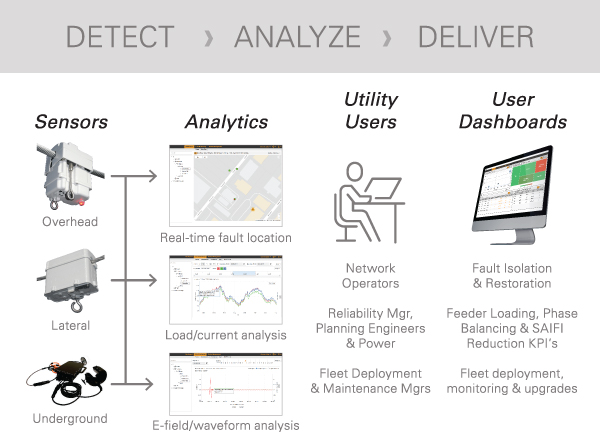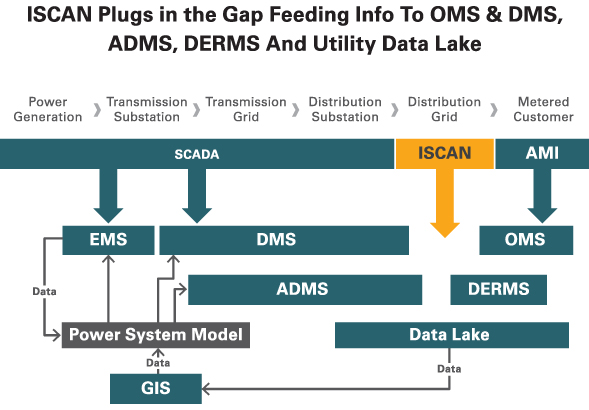The electrical distribution grid has been slow to evolve since its inception in the early 20th Century. The introduction of SCADA (Supervisory Control and Data Acquisition) systems in the 1960s and 1970s gave utility engineers their first real opportunity to understand and improve the health and performance of the distribution grid. This was quickly followed by the introduction of the Distribution Management System (DMS) and the Outage Management System (OMS) in the 1980s and 1990s. These tools allowed system dispatchers to oversee the entire distribution grid from a central operations and dispatch center. The mid-2000s brought the advent of smart meters and Advanced Metering Infrastructure (AMI) network. This opened up a new set of data and information that enabled utility operators to better understand and react to customer concerns and issues. The evolution of software enterprise systems coupled with the increased capability of data storage and management drove the acceleration of big data analysis and helped create the “data lake” concept.
Although these advances in hardware and software technology have led to some improvements in overall performance over the past 30 years, grid capability and design have not evolved to the levels achieved by the communication and transportation industries. Public Service Commissions continue to pressure utilities and electrical energy suppliers to improve reliability, performance and power quality while maintaining or reducing operating costs. These pressures, combined with aging grid infrastructure and the proliferation of distributed generation are the primary drivers for fundamental change in both the capability and performance of the distribution grid. However, the integration of technology and grid automation will simply not be sufficient to address current and future consumer needs.
Minding the Grid Information Gap
Technology has produced many components and partial solutions focused on distribution grid transformation. Grid edge devices and data-analytics programs continue to support grid automation and often offer improvement for targeted areas. Currently, there is significant data and information available at both the source (substation SCADA and DMS) and the load (smart meters and AMI network). SCADA systems provide detailed data capture from the bulk generators up to and including substations. AMI networks now give complete customer information regarding delivery, usage and performance. Although this information is necessary and valuable, it is incomplete and not capable of being the sole support for an interactive grid.
The 21st Century “thinking grid” requires an infrastructure layer, that combined with SCADA and AMI networks, will enable complete and accurate data flow and intelligence throughout the entire distribution grid. This will not happen as long as there remains an information gap on the entire network and connecting infrastructure between substation and customer meter, which, at six million miles in North America alone, is the largest, most costly and most vulnerable part of the grid. The 21st Century intelligent distribution grid must address all current and future issues regarding grid performance along the entire power delivery value chain, distributed generation, aging infrastructure and the full integration of all systems and data.
The Missing Link - Intelligent Sensing Control and Analysis Networks (ISCAN)
Today’s electrical power delivery chain depends primarily on centralized bulk generation with rapid growth in distributed generation. The majority of critical information available today is captured through SCADA systems, substation and grid device monitoring, and AMI networks. This information is used to generate, calibrate and correct the network models and provides inputs to control and management systems such as the EMS, OMS and (A)DMS. Currently, these models limit the ability to operate and maintain the grid at optimum performance and do not meet the expectations and requirements of today’s utilities or their customers.
Detailed information from generation to/and including the distribution substation is available through SCADA and other monitoring devices, while pertinent customer usage and information are now available through AMI networks. SCADA systems changed the way the industry approached control and monitoring of the electrical systems and led to increased reliability and performance. They also helped lower both capital and operating costs. The AMI networks have given insight into customer usage and trends. This has helped to improve performance and has begun to enable predictive maintenance at the grid edge.
The current information gap and primary limitation to an accurate network model centers around the distribution grid itself. Limitations and inaccuracy of the model limit the effectiveness of control and management systems. This creates sub-optimal grid reliability and performance. In its current state, the distribution grid is not capable of meeting today’s requirements.
Shortfalls include:
- Inability to immediately locate faults and the cause of an outage
- Inability to detect a non-outage disturbance
- Inability to detect load shifts, load imbalances and other power quality issues at the feeder and lateral levels
- Inability to identify abnormalities and predict potential faults and outages
- Inability to meet requirements necessary to address new challenges created by the rapid increase in microgrids and distributed generation
- Inability to integrate grid edge control devices into the overall grid control
In order to have a complete and accurate model of the electrical power delivery chain, utilities must have a thorough understanding of current activity and condition of the distribution grid. This requires a network of intelligent data/information gathering devices with or without control capability. Intelligent Sensing Control and Analysis Network (ISCAN) fills the void currently left by SCADA and AMI networks and provides a real-time, complete network model that enables both preventive and prescriptive analytics so the grid performance limitations listed above can now be addressed.
ISCAN is a straightforward and basic concept, which will enable true grid transformation and have a significant and positive effect on grid performance in the areas of safety, reliability, power quality, cost control and lifecycle extension. There is a strong set of requirements for a complete and effective ISCAN network that creates significant challenges, constraints and technical obstacles. Network requirements include both sensing elements (Field End Devices) and Enterprise Software.

Figure 1: Intelligent Sensing, Control & Analytics Network for Distribution Grid
ISCAN Sensing Element Requirements:
- Must be ubiquitous; reach all overhead and underground circuits
- Must be multi-communications capable; working through multiple diverse communication networks
- Must be environmentally capable of all grid environments and conditions
- Must have highest signal capture fidelity to support all Grid needs, including Predictive Analytics and Distributed Generation
- Must have strong analytics and storage capability
- Must be able to integrate with any ADMS
Note: Field testing has shown that some field disturbances and abnormalities are only detected at the 15th harmonics or higher.
ISCAN Enterprise Software Requirements:
- Must be capable of managing 20K to 100K devices
- Must meet all security requirements
- Must be on-premise or cloud capable
- Must be capable of integrating multiple communication protocols
- Must be capable of integrating multiple types of field sensing elements; underground, overhead, low/ high current, voltage, etc.
- Must be capable of housing/enabling libraries of waveforms sustained faults, momentaries, disturbances, load changes, maintenance activities (capacitive switching)
- Must be capable of integrating with multiple utility OT systems; ADMS, Historian, EMS, OMS, etc.
Benefits and Capabilities
Though the requirements of an Intelligent Sensing Control and Analysis Network are quite rigorous, with numerous technological challenges, the benefits towards grid performance can be game-changing. Reliability and power quality will go up substantially while cost should decrease dramatically.
Benefits include:
- Lifecycle extension and improved system planning through optimum phase balancing, load and line management and an accurate connectivity view
- SAIDI reduction due to immediate fault location detection
- Pre-fault sensing and prediction (vegetation issues, device pre-failure, etc. detection)
- Load direction, power quality monitoring and improvement recommendations necessary to meet distributed generation needs
- Sustained fault, momentary fault and disturbance waveform libraries used for planning and improvement purposes (Load change and maintenance waveforms may be included)
- Connectivity and proper phasing identification
- Advanced analytics; Disturbance management, high impedance detection, etc. (to address safety concern, wire down)

Figure 2: Intelligent Sensors, Advanced Analytics and Integration with Multiple Systems Provides Substantial Reliability and Power Quality Benefits
Disturbance Management – Advancing Beyond SAIDI and CAIDI Reduction
Disturbance management leverages the high-resolution oscillography required in an advanced sensing network and provides analytics tools, software visualization and integration with operational utility systems. Grid disturbances are both normal and abnormal events (deviations from the steady-state power flow) that occur on utility networks every day. Some examples are sustained and momentary faults and voltage anomalies that are managed by ADMS or other systems controlling substation equipment and distribution line capacitors. Other examples include non-fault and load anomalies that typically go undetected today due to the limited amount of sensing equipment between the substation and the customer meter, as well as the lower resolution of data captured by today’s control and monitoring equipment. In many cases, non-fault disturbance anomalies are precursors to new sustained faults, momentary faults and power quality events. Ubiquitous sensing at the feeder, lateral and underground level is required to detect these anomalies.
By leveraging network models provided by the sensing network, an ADMS can pinpoint the source of the anomaly so that mitigation can be performed by maintenance crews. Overhead feeder level sensing, alone, has limitations in detecting and pinpointing disturbances since many of these anomalies originate at locations that are a considerable distance downstream from the feeder-level sensors on overhead laterals, or underground cables and equipment. By leveraging sensors across the various levels of the distribution grid, ISCAN, enabled by disturbance management, will provide the tools necessary to reduce the frequency of sustained and momentary outages that is required for utilities to achieve greater benefits by reducing the frequency of outages with proactive detection, and the pinpointing and mitigation of pre-fault disturbances. Disturbance management will enable ISCAN to go beyond benefits associated with SAIDI and CAIDI reductions by utilizing the capabilities of an advanced intelligent sensing network.
Ultimately, the goal of disturbance management is to detect the “pre-fault signatures” associated with sustained and momentary faults that are caused today by failing overhead and underground equipment, vegetation and other issues that occur at any level of the network. The tools and processes to develop these signatures have been challenging due to the limited number of sensing locations and the accuracy level of these sensors. However, this limitation is being addressed, and sensors are now available for the entire grid to provide the level of accuracy required to detect and analyze low-level disturbances. ISCAN can now be enabled to support utility efforts to identify grid anomalies, which, if not addressed, will continue to cause new sustained and momentary outages. Disturbance management provides an incremental approach to achieving the ultimate goal of classifying non-fault disturbances with pre-fault signatures (cause codes).
Evolution and Adoption of ISCAN-Level Technology
CFCI (Communicating Fault Current Indictor) has been around for a decade. Many have claimed to be or have been mistaken for intelligent sensors. Most lack the robustness, fidelity, communication flexibility and computational capability to support ISCAN. The reality is that the industry is at a tipping point and remains at the introductory stage of this evolution. Early adopters are beginning to see the benefits and are positioning themselves to remain leaders in performance, cost and reliability. There are few technologies that have reached the ISCAN level, and they have proven themselves in many areas. Adoption of this technology has been slow to date but has now reached the fast-follower stage and is approaching mainstream acceptance. Advanced analytics, waveform libraries, disturbance detection, disturbance management and predictive analytics, though in their early stages, are a reality and are already proving effective.
Grid transformation is a reality and a necessity. It is upon the industry now and will continue to accelerate rapidly. Pressure from regulators, the onset of distributed generation and aging infrastructure will accelerate the rate of transformation. ISCAN is the missing link for a complete and accurate network model required to meet new and ongoing needs. Technology will continue to improve. ISCAN adoption will accelerate, integration with ADMS will become a requirement and performance will improve.
ISCAN will evolve and with it the grid. Disturbance management will be the norm, not the exception, and the ADMS will be able to see and touch all parts of the grid with a highly-accurate model.
 James “Jim” Keener joined Sentient Energy in 2014 as Chief Executive Officer. Before joining Sentient Energy, he was vice president, technical services for the Power Generation Division of NextEra Energy, Inc., where he was responsible for all technical and engineering activities associated with NextEra Energy’s non-nuclear assets worldwide. In his most recent role at NextEra Energy, Keener served as Florida Power & Light Company’s vice president of transmission & substations and was responsible for overseeing the delivery of electricity from all generating sources to the distribution network, and to wholesale customers through FPL’s transmission system. Keener was a part of the effort that resulted in FPL receiving the first Deming prize awarded to a non-Japanese company.
James “Jim” Keener joined Sentient Energy in 2014 as Chief Executive Officer. Before joining Sentient Energy, he was vice president, technical services for the Power Generation Division of NextEra Energy, Inc., where he was responsible for all technical and engineering activities associated with NextEra Energy’s non-nuclear assets worldwide. In his most recent role at NextEra Energy, Keener served as Florida Power & Light Company’s vice president of transmission & substations and was responsible for overseeing the delivery of electricity from all generating sources to the distribution network, and to wholesale customers through FPL’s transmission system. Keener was a part of the effort that resulted in FPL receiving the first Deming prize awarded to a non-Japanese company.
Keener earned a Bachelor of Science degree in electrical engineering from the University of Florida, Master of Business Administration from Nova Southeastern University and is a graduate of the Program for Management Development at Harvard University. He holds U.S. patents for Dispatchable Renewable Energy Generation, Control, & Storage Facility and System & Methods for Air Intake Filter Assemblies. He has authored and presented for industry groups for Power Generation and Combustion Turbine Technology. Keener was named “2015 Smart Grid Pioneer” by Smart Grid Today.






